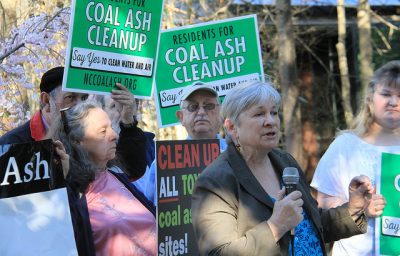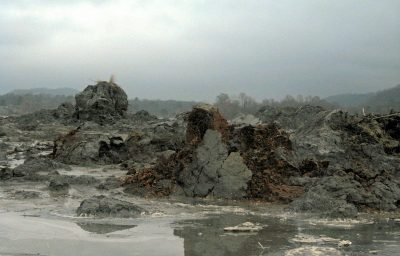Front Porch Blog

EPA administrator Scott Pruitt in 2015. Photo from Creative Commons
If creating rules to protect the environment from the second largest waste stream in the U.S. is considered a “war on coal,” then the way to end the war is simple. One just needs to slay all the rules which stipulate that the coal industry protect the environment from its toxic waste. Problem solved, right?
It sounds ludicrous, I know, but this is the battle plan being peddled by Scott Pruitt, head of the Environmental Protection Agency. There are far-reaching implications for our health and our natural resources that come from removing basic safeguards against pollution.
Under Pruitt, the EPA has hit the ground running (backwards, that is) on its safeguards for our water already this year. I suppose this shouldn’t come as a surprise to anyone if last year was an indicator. (ICYMI: Check out “A Running List of How Trump Is Changing the Environment” by National Geographic, or “23 Environmental Rules Trump Rolled Back in His First 100 Days” by the New York Times.)
September 2017
Last September, the EPA delayed the new Effluent Limitation Guidelines (ELGs), which it had passed just the year before (under a decidedly different administration) to reduce the wastewater pollution from coal-fired power plants by more than 95 percent for copper, lead, mercury, nickel, selenium, thallium and zinc, and more than 90 percent for arsenic and cadmium. All told, the ELGs would reduce the amount of pollutants from the plants by 1.4 billion pounds per year. Pruitt said the delay was for “providing relief from the existing regulatory deadlines while the agency revisits some of the rule’s requirements…” No doubt he plans to weaken them.
February 20, 2018
Pruitt’s newest gifts to polluting coal-burning facilities started February 20, when the EPA asked for public feedback on whether it should reconsider its long-standing position that, in layman’s terms, pollutants that travel through groundwater into surface waters that are covered by the Clean Water Act are also covered by the law. The law is based on the understanding that pollutants can move from a source (like, oh, say an unlined coal ash pit) through the groundwater, in some cases for long distances (See also: Superfund sites).

Members of the Alliance of Carolinians Together (ACT) Against Coal Ash hold a press conference outside of a public hearing in March 2016.
Why does this “groundwater connectivity” issue matter? Communities that are fighting contamination of their drinking water wells and local waterways where their families fish and swim rely on the law’s protection. The agency’s apparent retreat from its own position on the applicability of the Clean Water Act was this year’s first red flag for those working to hold electric utilities accountable for their waste and the impacts it inflicts on neighboring communities.
March 1, 2018
Then, on March 1, the EPA announced the first of two actions that will essentially subvert the Coal Combustion Residual Rule (CCR) it passed just three years ago (also under the aforementioned different administration). It was the first federal rule created to regulate coal ash — it established minimum national criteria and siting and closure requirements, and it required that various technical reports be made available online to disclose information to the public. (History note: The 2015 rule was the result of a citizen lawsuit forcing the EPA to regulate coal ash after 30 years of inaction. See below for more on citizen lawsuits.)
You can read more details about the March announcement from our friends at EarthJustice, or EPA’s own characterization of the Phase One rollback. In short, it includes proposals to either eliminate or relax provisions for:
- Groundwater monitoring requirements
- National groundwater protection standards
- Cleanup and closure standards
- Location restrictions for siting coal ash dumps in groundwater, wetlands, floodplains and fault areas
- When cleanup is required at a site
- How long the utilities must monitor their closed sites
There are half a dozen other provisions as well, including letting the states run their own programs — which is the situation we had for the 30 years, and that clearly worked out (not).
March 2, 2018
Ironically, the very next day marked an important milestone. March 2 was the deadline for power plants to release the results from the first annual, nationwide groundwater monitoring testing as required under the CCR. The results are deeply disturbing. From the biggest utilities like Duke Energy in North Carolina, Dominion Energy in Virginia, Georgia Power, Alabama Power and the Tennessee Valley Authority, to smaller utilities like Gainesville Regional Utilities in Florida, and City of Fremont and Omaha Public Power in Nebraska, most facilities documented water contamination at the sites of coal ash pits, including high levels of radioactivity. It’s disturbing, however not surprising, since most coal ash dumps are unlined, and many are located in groundwater, and that groundwater moves. (Refer back to February 20 above.)
The irony continued. Power company executives said further studies were needed to confirm if the ash sites are the source of the contamination and whether public drinking water supplies are threatened — yet, if they get their way, the requirement for further studies and all future monitoring will be deep-sixed, along with other commonsense requirements of both the CCR rule and likely the ELGs as well.
Thanks to the CCR, the data now accessible to the public validates years of community and advocate concerns over the scope of the threat posed by unlined coal ash pits. Another critical CCR provision on Pruitt’s chopping block is the ability of citizens to file lawsuits — one of the issues that the coal power industry finds offensive. According to this document from the Energy and Mineral Law Foundation, coal companies are considering how best to combat the citizen suits:
“The coal industry is under attack from environmental groups. Compliance with agency requirements is no longer enough. Coal power utilities need to take a proactive approach to reducing the likelihood of citizen lawsuits by [environmental non-governmental organizations]”
March 6, 2018
Under Pruitt’s EPA, citizen suits may fare little chance anyway. On March 6, just four days later, the EPA dealt another strike against communities who use the courts to compel the cleanup of coal ash contamination when it rejected the civil rights case of Uniontown, Ala., one of the clearest cases of environmental racism in the country. Our hearts go out to the Black Belt Citizens Fighting for Health and Justice (watch a 10-minute video on their story) who have spent more than a decade documenting the impacts of the 4 million tons of coal ash (from the notorious TVA spill in Kingston, Tenn.) dumped in the Arrowhead Landfill adjacent to their community.
While there is no “war on coal” and never was — unless you count the one dreamed up by the coal industry and its allies to defend themselves against the public health officials, natural resource protectors, and the public who are exposing their toxic truth — there is a war on. Pruitt and his troops are waging what amounts to a “war on the health of the American public” by removing the protections for our drinking water, our families and communities, and the air we breathe, and by raiding one of our most important defensive measures, citizen lawsuits.
The comment period for the groundwater connectivity issue is open; the EPA will soon open up a public comment period on the proposed CCR rollbacks. Check back with us to see how you can help us fight back on both.
Because, fight back we will.
PREVIOUS
NEXT

Leave a comment
Your email address will not be published. Required fields are marked *
4 responses to “EPA’s Pruitt leading a “war on America’s health””
-
The people in these areas vote Republican. Until they realize what they are doing to themselves, things won’t change. Pruitt is a result of Trump’s policies. If you vote for these polluters, you have no right to complain.
-
Thank you, Amy Adams, for pulling this information together in a way that helps me understand just how all the information rolls into what we are dealing with daily. Every citizen needs to have an understanding of “hearings or public comments” however, most of what people have to said just flies out the window but they do have to ofter comments periods, BUT do they actually use any comments? Also, remember that huge companies hold a lot of power and have lobbyists that continue to pull for their benefits. Citizens have to be WATCHFUL. I am thankful for groups that continue to bring us information and STAND TALL for our environment and or citizens.
-
I KNOW ALL ABOUT WHAT COAL ASH POLLUTION DOES TO A HUMAN BODY! I HAVE WATCHED MY ONLY CHILD WHO IS NOW 24 & BORN TO ME WHEN I WAS 46! GET SICKER AND SICKER AND I TOOK HER OFF OF OUR WELL WATER BACK IN THE SUMMER OF 2013 & put her on bottled water after finding our that there is arson in our well water! I LEARNED THIS THANK TO group AMY ADAMS WORKS FOR! IT MAY HAVE SAVED HER LIFE!
-
Thank you, Amy, for your truth-telling ways!! Yes, we’ll fight this together, community by community, statewide and unified!!


Leave a Comment